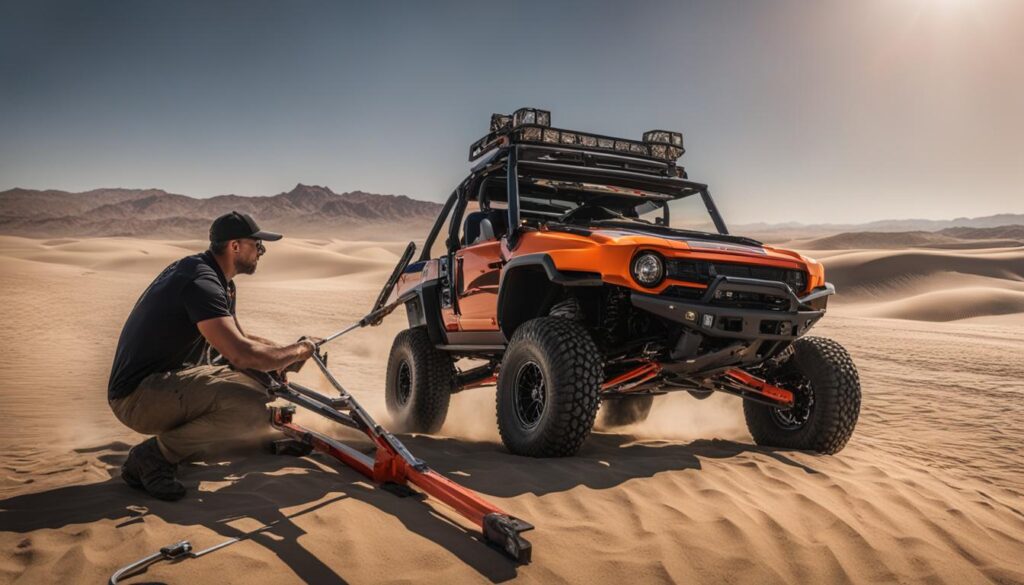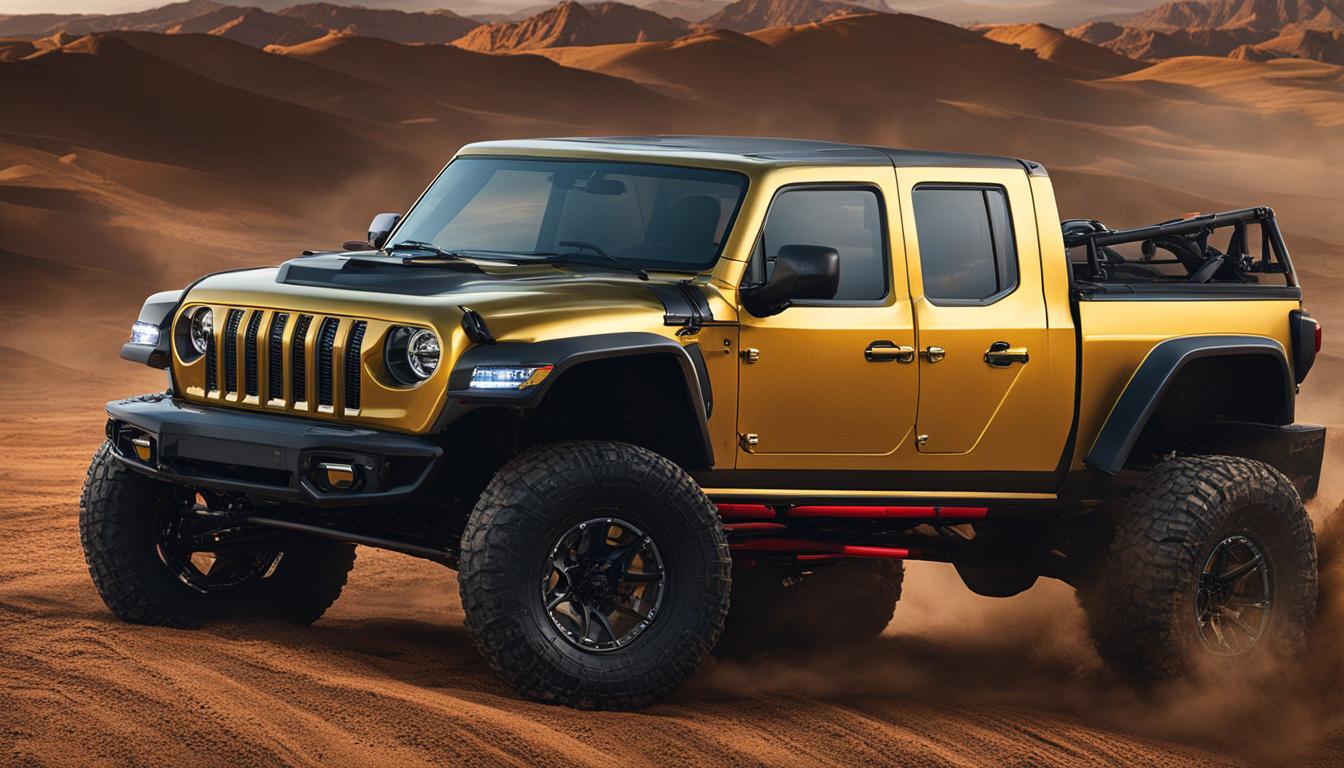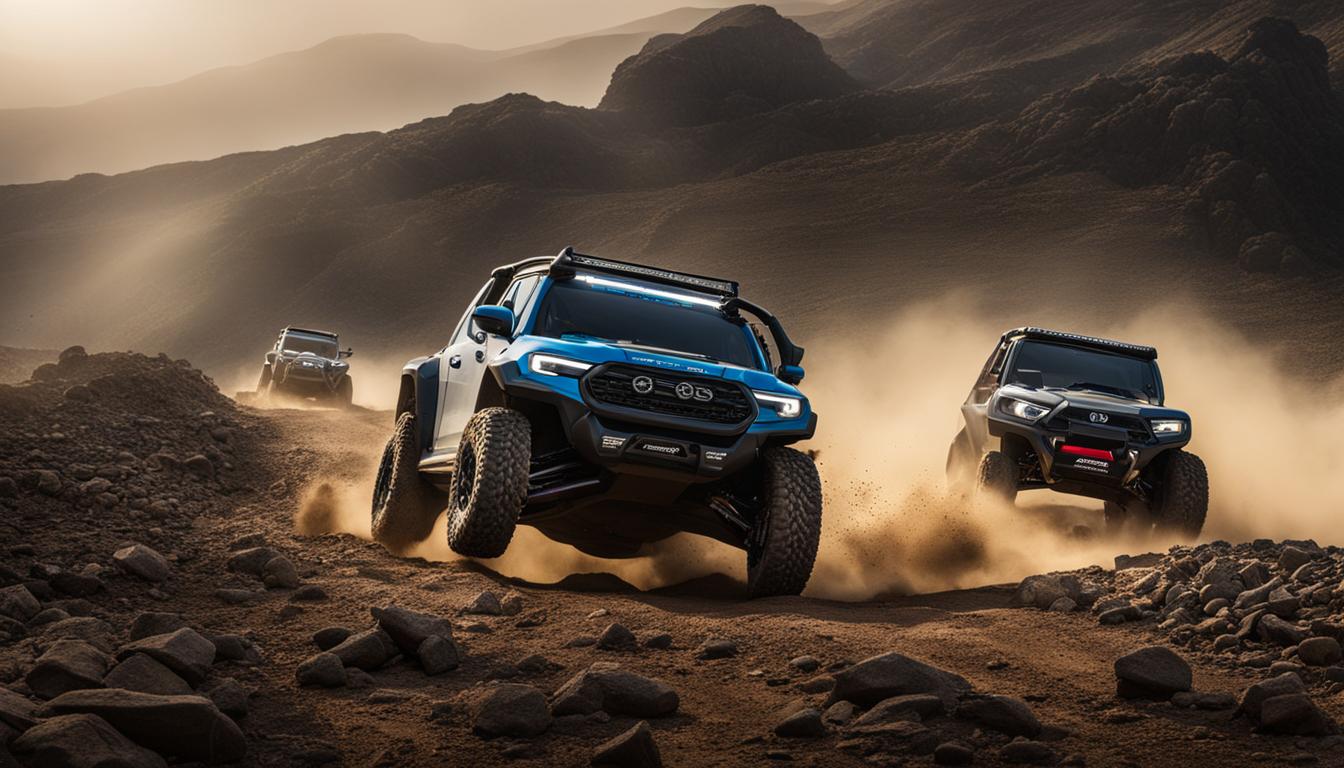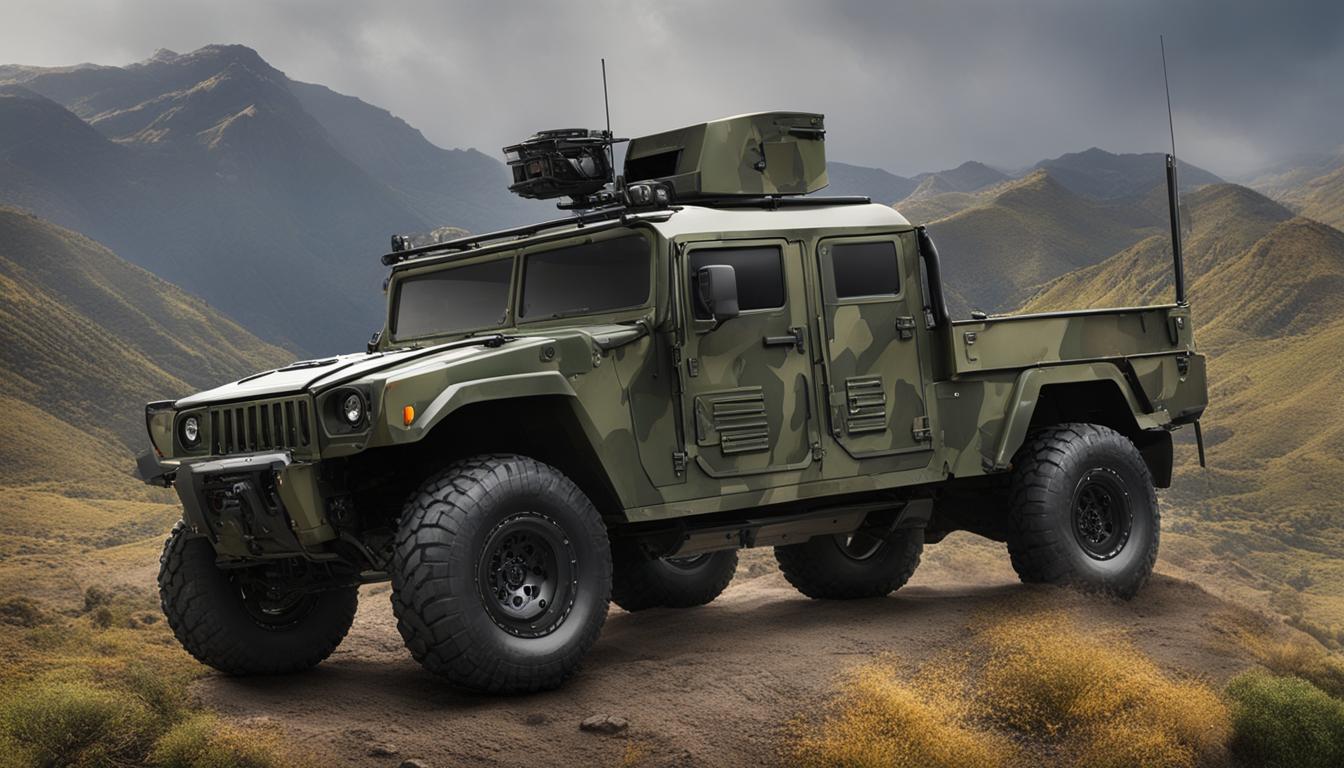Off-road stability is crucial for a smooth and controlled ride in challenging terrain. When it comes to enhancing off-road stability, two components play a significant role – sway bars and traction bars. While they both contribute to improved off-road handling and vehicle stability, they serve distinct purposes. Understanding the difference between these components is essential for making informed decisions when upgrading your off-road suspension.
Key Takeaways:
- Sway bars and traction bars are essential for enhancing off-road stability and handling.
- Sway bars reduce body roll during turns, improving cornering stability.
- Traction bars prevent axle wrap and rear wheel hop, ensuring efficient power transfer.
- Consider your specific off-road needs and driving conditions when choosing between sway bars and traction bars.
- Combining sway bars and traction bars can provide the ultimate off-road stability upgrade.
Sway Bars and Their Role in Off-Road Stability
When it comes to off-road stability, sway bars play a crucial role in enhancing the handling and control of a vehicle. Also known as anti-roll bars, sway bars are designed to minimize body roll during cornering and swerving maneuvers, resulting in improved stability and safety. These components are typically installed on the front and/or rear suspension systems to provide additional support and stability to the vehicle.
How do sway bars work? By connecting the opposite sides of the suspension, sway bars transfer force from the heavily loaded side to the opposite side of the vehicle. This transfer of force helps reduce the amount of weight shifting during cornering, which in turn minimizes body lean and enhances the vehicle’s handling capabilities. As a result, off-road enthusiasts can enjoy a more controlled and stable ride, especially when navigating tight turns or challenging terrains.
It is important to choose the right size and stiffness of sway bars for optimal performance. Larger sway bars are generally stiffer and provide more resistance to body roll, but they may also affect the vehicle’s articulation and suspension travel. Therefore, it is crucial to consider the specific needs and goals of the off-road vehicle, as well as the driving conditions it will encounter.
Benefits of Sway Bars for Off-Road Stability
Sway bars offer several benefits for improving off-road stability:
- Reduced body roll: Sway bars help minimize body roll during turns, allowing for better cornering and maneuverability.
- Improved stability: By limiting weight transfer, sway bars enhance overall stability and make the vehicle more predictable and responsive.
- Enhanced control: With reduced body lean, off-road enthusiasts have better control over their vehicle, especially when navigating uneven terrain or challenging obstacles.
In summary, sway bars are essential components for enhancing off-road stability. By reducing body roll and improving handling capabilities, these components provide off-road enthusiasts with a more controlled and stable ride. However, it is important to choose the right sway bar size and stiffness that best suit the specific vehicle and driving conditions.
Traction Bars and Their Role in Off-Road Stability
Traction bars are an essential component of off-road suspension systems, playing a crucial role in enhancing stability and control. Designed to prevent axle wrap and rear wheel hop, traction bars provide additional support to the rear axle, reducing the chances of power loss and instability during acceleration. By limiting excessive movement and maintaining proper traction, they ensure a smoother off-road ride.
One of the primary functions of traction bars is to prevent axle wrap, which occurs when torque from the engine causes the rear axle to twist under heavy acceleration. This twisting motion can lead to loss of traction and compromised stability, especially on uneven terrain. Traction bars counteract this by connecting the axle to the frame and providing extra reinforcement, effectively minimizing axle movement and maintaining consistent power transfer to the wheels.
In addition to reducing axle wrap, traction bars also help prevent rear wheel hop. During aggressive acceleration or sudden weight transfer, the rear wheels can experience uncontrolled bouncing, resulting in a loss of traction and control. Traction bars address this issue by stabilizing the rear axle and limiting the vertical movement of the wheels, ensuring improved grip and stability on challenging off-road surfaces.
Benefits of Traction Bars for Off-Road Stability:
- Prevents axle wrap and rear wheel hop
- Improves power transfer to the wheels
- Enhances traction and control
- Reduces the risk of power loss and instability
Overall, traction bars are a valuable addition to off-road vehicles, providing increased stability and control by reducing axle wrap and rear wheel hop. By addressing these issues, they help maintain optimal power transfer and traction, ensuring a more comfortable and controlled off-road experience. When considering off-road suspension upgrades, traction bars should be carefully chosen and installed to match the specific vehicle and driving conditions, ultimately enhancing overall off-road stability.
| Benefits of Traction Bars | Detailed Description |
|---|---|
| Prevents axle wrap | Traction bars connect the rear axle to the frame, minimizing axle twist and reducing the risk of power loss and instability during acceleration. |
| Reduces rear wheel hop | Traction bars stabilize the rear axle, limiting the vertical movement of the wheels and ensuring improved grip and control on challenging off-road surfaces. |
| Improves power transfer | By minimizing axle wrap and rear wheel hop, traction bars maintain consistent power transfer to the wheels, maximizing off-road performance. |
| Enhances traction and control | With reduced axle movement and improved power transfer, traction bars enhance overall traction and control in various off-road conditions. |
Benefits of Sway Bars for Off-Road Stability
Sway bars are a crucial component for improving off-road stability and reducing body roll during turns. By adding sway bars to your off-road vehicle, you can experience enhanced cornering stability and better overall handling. Here are some key benefits of sway bars for off-road stability:
- Body Roll Reduction: One of the primary advantages of sway bars is their ability to reduce body roll during turns. When you navigate tight corners or uneven terrains, sway bars help distribute the force evenly across the suspension, minimizing the lateral movement of the vehicle. This reduces the risk of rollovers and provides a more stable and controlled ride.
- Improved Cornering Stability: Sway bars play a vital role in enhancing cornering stability. They work by transferring the load from the heavily loaded side of the vehicle to the opposite side, reducing body lean and allowing for more predictable and responsive handling. With sway bars, you can confidently tackle challenging off-road obstacles and maintain stability even on rough terrain.
- Enhanced Handling: Installing sway bars can significantly improve the overall handling of your off-road vehicle. By minimizing body roll, sway bars help maintain proper weight distribution among all four wheels, providing better traction and control. This allows you to navigate corners more smoothly and make quick maneuvers with confidence.
“Sway bars offer a significant advantage in off-road stability by reducing body roll and enhancing cornering stability. Their ability to distribute the load evenly and minimize lateral movement ensures a safer and more controlled off-road experience.” – Off-Road Expert
In conclusion, adding sway bars to your off-road vehicle can offer numerous benefits for stability. From reducing body roll and improving cornering stability to enhancing overall handling, sway bars play a crucial role in achieving a more controlled and enjoyable off-road experience. Consider upgrading your off-road suspension with sway bars to take your off-road adventures to new heights of performance and stability.
| Benefits of Sway Bars for Off-Road Stability |
|---|
| Body Roll Reduction |
| Improved Cornering Stability |
| Enhanced Handling |
Benefits of Traction Bars for Off-Road Stability
Traction bars are a crucial component for enhancing off-road stability. They play a significant role in preventing axle wrap and rear wheel hop, which can lead to loss of traction and compromised control. By providing additional reinforcement to the rear axle, traction bars ensure efficient power transfer to the wheels, minimizing the chances of instability in challenging off-road conditions.
One of the key benefits of traction bars is their ability to prevent axle wrap. Axle wrap occurs when the torque generated by the engine causes the rear axle to twist, resulting in a loss of traction. This can be particularly problematic during acceleration, especially in terrain where traction is already limited. Traction bars counteract this movement by limiting the axle’s ability to twist, ensuring that power is effectively transferred to the wheels and maintaining stability.
Another advantage of traction bars is their ability to prevent rear wheel hop. When off-roading, especially in rough or uneven terrain, the rear wheels can experience sudden and unpredictable bouncing, leading to a loss of control. Traction bars minimize rear wheel hop by providing additional support and stability, keeping the wheels firmly planted on the ground. This helps maintain traction, improve control, and enhance overall off-road stability.
| Traction Bars | Sway Bars | |
|---|---|---|
| Function | Prevent axle wrap and rear wheel hop | Reduce body roll during turns |
| Benefit | Enhanced power transfer and traction | Improved cornering and handling |
| Effect | Minimize instability and loss of control | Decrease body lean and improve maneuverability |
When considering off-road stability upgrades, traction bars are an excellent choice for those seeking to enhance control and traction in demanding off-road conditions. Their ability to prevent axle wrap and rear wheel hop ensures a more stable and predictable off-road experience. Whether navigating challenging terrain or tackling obstacles, traction bars provide the necessary reinforcement to maintain stability and maximize power transfer for a more enjoyable off-roading adventure.
Comparison between Sway Bars and Traction Bars for Off-Road Stability
When it comes to enhancing off-road stability, both sway bars and traction bars have important roles to play. While they share the common goal of improving the overall stability of an off-road vehicle, their functions differ significantly. Understanding the differences between these two components is essential for making an informed decision on which upgrade to choose.
Sway bars, also known as anti-roll bars, are designed to limit body roll during cornering and swerving maneuvers. They are typically installed on the front and/or rear suspension to provide additional stability to the vehicle. By connecting the opposite sides of the suspension, sway bars transfer force from the heavily loaded side to the opposite side, minimizing body lean and enhancing handling capabilities. This helps to reduce the risk of rollovers and increases overall control and stability during off-road adventures.
Traction bars, on the other hand, focus on preventing axle wrap and rear wheel hop. When off-roading, the torque generated by the engine can cause the rear axle to twist, resulting in the loss of traction and instability. Traction bars provide additional support to the rear axle, counteracting this movement and ensuring efficient power transfer to the wheels. By reducing axle movement, traction bars enhance traction, control, and stability in off-road conditions, making it easier to navigate challenging terrains.
Ultimately, the choice between sway bars and traction bars depends on the specific needs and goals of your off-road vehicle, as well as the terrain and driving conditions you’ll encounter. If you’re looking to improve cornering stability and minimize body roll during turns, sway bars are the way to go. On the other hand, if you’re dealing with axle wrap and rear wheel hop issues, traction bars are the solution of choice. In some cases, a combination of both sway bars and traction bars may be needed to achieve the ultimate off-road stability.
| Sway Bars | Traction Bars |
|---|---|
| Reduce body roll during turns | Prevent axle wrap and rear wheel hop |
| Enhance cornering stability | Ensure efficient power transfer to the wheels |
| Improve handling and control | Enhance traction and stability |
| Minimize the risk of rollovers | Reduce the chances of losing traction |
Considerations for Installing Sway Bars or Traction Bars
When considering upgrades for off-road stability, the installation of sway bars or traction bars can significantly enhance the performance of your vehicle. However, it is essential to take into account certain factors before making a decision.
Weight Distribution and Suspension Design
The first consideration is the weight distribution and suspension design of your off-road vehicle. Each vehicle has a unique setup, and different suspension systems may require specific types of sway bars or traction bars. It is crucial to choose components that are compatible with your vehicle’s weight distribution and suspension design for optimal performance.
Intended Use and Terrain
Another aspect to consider is the intended use and the type of terrain you will be driving on. If you frequently encounter uneven or challenging off-road conditions, sway bars may be more beneficial for reducing body roll and enhancing cornering stability. On the other hand, if you experience axle wrap or rear wheel hop during acceleration, traction bars can help prevent these issues and improve overall stability.
Proper Installation and Manufacturer Recommendations
Lastly, it is essential to follow proper installation procedures and adhere to the recommendations provided by the component manufacturers. Improper installation can result in subpar performance and potential safety hazards. Always refer to the installation instructions and consult with professionals if necessary to ensure that sway bars or traction bars are installed correctly for optimal functionality and safety.
By considering these factors, you can make informed decisions when installing sway bars or traction bars to improve off-road stability. Remember to assess your vehicle’s weight distribution, suspension design, intended use, and follow proper installation procedures to maximize the benefits of these upgrades.

Upgrading Off-Road Stability with Sway Bars
Enhancing off-road stability is crucial for a smooth and controlled off-road experience. One effective way to achieve this is by upgrading your vehicle with sway bars. Sway bars, also known as anti-roll bars, play a significant role in reducing body roll during turns, resulting in improved cornering and maneuverability.
By connecting the opposite sides of the suspension, sway bars transfer force from the heavily loaded side to the opposite side, effectively minimizing body lean and enhancing overall stability. This means you can tackle tight corners and challenging terrain with greater confidence, knowing that your vehicle will remain stable and responsive.
“Upgrading off-road stability with sway bars can significantly improve handling and control.”
When considering sway bars for your off-road vehicle, it’s essential to choose the right size and stiffness based on your vehicle’s weight, suspension setup, and intended use. A properly matched sway bar will provide the ideal balance between body roll reduction and maintaining suspension articulation for maximum performance.
To visualize the benefits of sway bars, refer to the table below that summarizes the advantages of upgrading off-road stability with sway bars:
| Benefits of Sway Bars for Off-Road Stability |
|---|
| 1. Reduced body roll during turns |
| 2. Improved cornering and maneuverability |
| 3. Enhanced stability on uneven terrain |
| 4. Minimized chances of rollovers |
| 5. Increased predictability and responsiveness |
By upgrading off-road stability with sway bars, you can transform your off-road adventures into thrilling and safe experiences. Experience the benefits of reduced body roll, improved cornering, and enhanced overall control as you conquer the trails with confidence.
Summary:
- Upgrading off-road stability with sway bars improves handling and control.
- Sway bars reduce body roll during turns, enhancing cornering and maneuverability.
- Choosing the right size and stiffness is important for optimal performance.
- Benefits of sway bars include reduced body roll, improved stability, and increased predictability.
Upgrading Off-Road Stability with Traction Bars
Traction bars are a valuable addition to off-road vehicles, offering numerous benefits for improving stability. By preventing axle wrap and rear wheel hop, traction bars ensure efficient power transfer to the wheels, enhancing overall traction and control in challenging off-road conditions.
One of the key advantages of using traction bars is the reduction of axle wrap. When a vehicle’s torque causes the rear axle to twist excessively, it can result in loss of traction and stability. Traction bars provide additional reinforcement to the axle, preventing it from twisting and maintaining better power transfer to the wheels. This not only improves off-road traction but also reduces the chances of wheel hop, which can be particularly useful when navigating rough terrain or climbing obstacles.
With traction bars installed, off-road enthusiasts can experience improved stability and control during acceleration. The enhanced power transfer to the wheels ensures better traction, enabling the vehicle to maintain its momentum and conquer challenging off-road terrains. Additionally, traction bars help minimize the potential for wheel hop, which can cause sudden jolts and instability, especially when driving over uneven surfaces or during aggressive acceleration.
| Benefits of Traction Bars for Off-Road Stability |
|---|
| Prevents axle wrap |
| Reduces rear wheel hop |
| Improves power transfer to the wheels |
| Enhances off-road traction and control |
When considering the installation of traction bars, it is important to choose a high-quality product that is specifically designed for the make and model of your off-road vehicle. Proper installation is crucial to ensure optimum performance and safety. It is also important to note that while traction bars are beneficial for off-road stability, their effectiveness may vary depending on the vehicle’s suspension design, weight distribution, and other modifications.
By upgrading off-road stability with traction bars, off-road enthusiasts can enjoy enhanced control, improved traction, and increased stability while tackling challenging terrains. Combined with other off-road upgrades, such as sway bars, these components contribute to a more capable and reliable off-road vehicle.
Improving Off-Road Stability with a Combination of Sway Bars and Traction Bars
When it comes to enhancing off-road stability, a combination of sway bars and traction bars can provide the ultimate solution. By integrating these two components, off-road enthusiasts can maximize the benefits of each, resulting in improved handling, control, and overall stability in various off-road conditions.
Sway bars play a crucial role in reducing body roll during turns, enhancing cornering and maneuverability. By connecting the opposite sides of the suspension, sway bars minimize weight transfer, resulting in a more controlled and stable ride. Paired with traction bars, the combination can effectively address body roll issues while also preventing axle wrap and rear wheel hop.
Traction bars, on the other hand, focus on limiting axle wrap and rear wheel hop, ensuring efficient power transfer and better traction. By reinforcing the rear axle and minimizing its movement, these bars provide added stability during acceleration, especially for vehicles with high torque or heavy modifications. When combined with sway bars, the overall stability and control of the off-road vehicle are significantly enhanced.
In summary, a combination of sway bars and traction bars is the ideal solution for improving off-road stability. By reducing body roll during turns and minimizing axle wrap and rear wheel hop, this combination offers superior handling, control, and traction. Off-road enthusiasts can confidently navigate challenging terrain and overcome obstacles with enhanced stability and confidence.
Table: Comparison between Sway Bars and Traction Bars
| Sway Bars | Traction Bars | |
|---|---|---|
| Function | Reduce body roll during turns | Prevent axle wrap and rear wheel hop |
| Enhancements | Improved cornering and maneuverability | Efficient power transfer and traction |
| Benefits | Minimized weight transfer, controlled ride | Reinforced rear axle, better acceleration |
| Best Suited For | Vehicles with body roll issues | Vehicles with high torque or heavy modifications |
Conclusion
In conclusion, upgrading off-road stability with sway bars or traction bars can greatly enhance the performance and control of your vehicle. Sway bars are designed to reduce body roll during turns, improving cornering abilities and overall maneuverability. Traction bars, on the other hand, prevent axle wrap and rear wheel hop, ensuring better power transfer and traction, especially in challenging off-road conditions.
Both sway bars and traction bars can be installed individually to address specific stability issues or used in combination for maximum effect. By choosing the right components and considering the specific requirements of your off-road vehicle, you can significantly improve its stability, handling, and control.
Remember to carefully assess your vehicle’s suspension design, weight distribution, and intended use before installing sway bars or traction bars. Follow manufacturer recommendations and ensure proper installation to ensure optimum performance and safety. Whether you opt for sway bars, traction bars, or a combination of both, these off-road stability upgrades can enhance your driving experience and make your off-road adventures safer and more enjoyable.
FAQ
What is the difference between sway bars and traction bars in off-road stability?
Sway bars help reduce body roll during turns, while traction bars limit axle wrap and rear wheel hop.
What is the role of sway bars in off-road stability?
Sway bars minimize body roll during cornering, enhancing handling and control.
What is the role of traction bars in off-road stability?
Traction bars prevent axle wrap and rear wheel hop, ensuring better power transfer and traction.
What are the benefits of sway bars for off-road stability?
Sway bars reduce body roll, providing a more controlled and stable ride during turns.
What are the benefits of traction bars for off-road stability?
Traction bars prevent axle wrap and rear wheel hop, improving stability and maintaining traction.
How do sway bars and traction bars compare for off-road stability?
Sway bars primarily reduce body roll during turns, while traction bars focus on preventing axle wrap and rear wheel hop.
What should be considered when installing sway bars or traction bars?
Factors such as the vehicle’s suspension design, weight distribution, and intended use should be taken into account.
How can sway bars upgrade off-road stability?
Sway bars minimize body roll, improving handling and control in various off-road conditions.
How can traction bars upgrade off-road stability?
Traction bars prevent axle wrap and rear wheel hop, ensuring better power transfer and traction in demanding terrain.
How can a combination of sway bars and traction bars improve off-road stability?
Combining sway bars and traction bars maximizes the benefits of both components, addressing body roll and axle wrap.
 Skip to main content
Skip to main content


